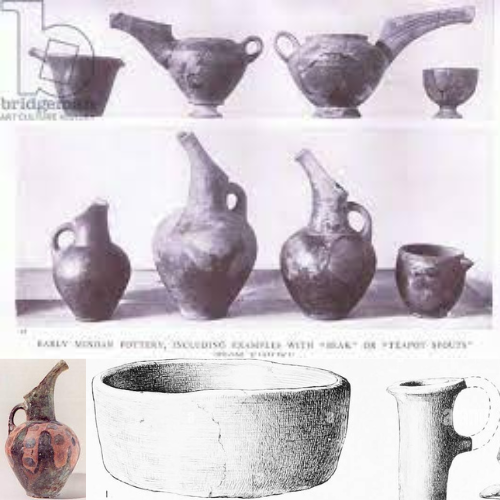Table of Contents
Introduction: The Dawn of Change in Late Neolithic Crete
The Late Neolithic period in Crete was a time of significant transformation. This era witnessed a convergence of new agricultural methods, social structures, and technological advancements, all of which played a pivotal role in shaping the island’s future.
Arrival of New Migrants: Anatolian Influence
Around 7000 BC, Crete saw the arrival of new settlers from Anatolia. These migrants brought with them domesticated animals and Anatolian soft wheat, significantly impacting the agricultural landscape of Crete. Their integration led to a blend of cultures, reshaping the island’s societal fabric.
Village of Kephala: A Reflection of Neolithic Life
The village of Kephala at Knossos, one of Crete’s oldest Neolithic sites, epitomized the era’s lifestyle. Early settlers built mud and reed houses and lived in small, kinship-based groups. Their life revolved around raising animals, harvesting crops, and crafting tools from materials like stone, obsidian, and bone. The village was also rich in symbolic art, as evident from clay figurines depicting human and animal forms, which possibly held religious significance.

Architectural and Social Developments
During the Early Neolithic period, Kephala housed 200–600 people per generation in square-plan mud-brick houses. These dwellings had stone foundations and flat mud roofs, divided into multiple compartments, illustrating a sophisticated understanding of living space and community organization. As the Middle Neolithic period arrived, these settlements expanded, accommodating up to 1000 people per generation. The construction techniques improved, with the introduction of features like windows, wooden doors, and more structured living spaces.
Late Neolithic: Arrival of Anatolian Migrants and Social Evolution
The Late Neolithic period marked another wave of migration from Anatolia, bringing significant cultural and technological shifts. These newcomers introduced pottery and terracotta to Crete, signaling a move towards more advanced manufacturing and artistic expression. They settled in large village communities and engaged in long-distance trade, hinting at the early stages of a market economy.
The Rise of Metalwork and Social Stratification
The “metal revolution” in the Late Neolithic period was a gradual transformation rather than an abrupt change. It began with the introduction of metallurgy, leading to the creation of tools and weapons from metals like arsenical copper and bronze. This shift from stone, obsidian, and bone to metal tools marked a significant advancement in technology and craftsmanship.
The Cretans: Farmers and Traders
Despite their agricultural prowess, the Cretans lacked local metal resources, which they compensated for through trade. They exchanged surplus agricultural produce, fabrics, and ceramics for metals, turning the Aegean Sea into a hub of maritime trade and cultural exchange.
Economic Changes: The Role of Trade and Metalwork
The Late Neolithic era in Crete was not just about cultural and technological shifts; it also witnessed significant economic changes. The development of metalworking and the subsequent ‘metal revolution’ dramatically altered the island’s economic landscape. Metallurgy, involving the extraction and smelting of metal ores, became a key industry. Itinerant blacksmiths, leveraging the island’s wooded slopes for resources, played a crucial role in this burgeoning industry. The emergence of full-time artisans and merchants signified a departure from purely kinship-based societal structures, heralding a more complex economic system.
Maritime Ventures and Trade Networks
The demand for metal and other resources led to the expansion of long-distance trading networks. Cretans, driven by the high profit margins and the scarcity of certain resources on the island, embarked on perilous sea voyages across the Aegean. These expeditions not only brought wealth but also enhanced the social and political status of those who engaged in them. This period saw individuals assert themselves within their communities, leveraging their ability to procure necessary materials and master new techniques like metallurgy.
Agricultural Surplus and Social Dynamics
The Cretans’ proficiency in agriculture resulted in bountiful harvests, often producing more than what was needed for survival. This surplus laid the foundation for an exchange-based economy. The lack of metal resources in Crete led to a unique economic situation where agricultural products, fabrics, and ceramics were traded for metals, necessary for the growing metallurgical industry.
Technological Advancements and Cultural Developments
The Late Neolithic period was marked by a significant evolution in technology and culture. In settlements like Kephala and Phaistos, architectural advancements were evident, with houses now featuring timber and mud-brick construction and more defined living spaces. The use of terracotta or stone for religious figurines suggests a flourishing artistic culture, possibly linked to cultic practices. These figurines, often emulating Cycladic forms, indicate a deepening of religious and cultural expression.
Population Growth and Expansion
The village of Kephala, in particular, experienced substantial population growth during this period. As the population increased, the village expanded, covering a larger area and developing external relations. This expansion reflects not only population dynamics but also the increasing complexity of social, economic, and political interactions within and beyond the village.
Conclusion: Prelude to the Bronze Age
The Late Neolithic transformation in Crete set the stage for the ensuing Bronze Age. This era of change was characterized by a blend of economic, technological, and cultural developments that reshaped the island’s societal fabric. The advancements in agriculture, metallurgy, and trade, coupled with the growth of artistic and religious expression, marked a pivotal shift in Crete’s history.
The Late Neolithic period, therefore, was not merely a transitional phase; it was a time of profound transformation that laid the groundwork for the rise of the advanced Minoan civilization and its remarkable contributions to human history.


